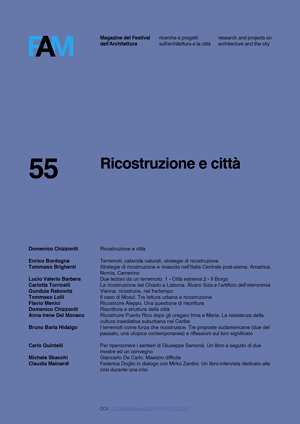Pubblicato 2021-08-30
Parole chiave
- Riscrittura,
- Ricostruzione,
- Struttura della città,
- Figurazione
Come citare
Abstract
Mutuando da pratiche letterarie l’attitudine a rielaborare criticamente caratteristiche
formali appartenenti a qualcosa di precedente, la riscrittura si offre come una possibile tecnica per trasformare parti di città. Tale approccio permette di evitare operazioni mimetiche, evidenziando invece la trama sostanziale della città, selezionandone gli elementi esemplari.
L’intento riscrittivo scompone il rapporto tra memoria, intesa come oggetto dell’azione progettuale, e la narratività, che è l’azione che rappresenta,
attraverso la costruzione, lo spazio della memoria. Nei casi studio proposti di Aleppo e Mosul, profondamente mutilati dopo le vicissitudini belliche degli ultimi dieci anni, il rapporto tra memoria e narratività diventa una questione cruciale per coinvolgere operativamente il contesto e le sue assenze, dando al progetto la capacità interpretativa di conferire valori e significati nuovi alla città.
Riferimenti bibliografici
- Al-Kubaisy F. (2010) – Mosul: The Architectural Conservation, in “Mosul Old Town”, Createspace, Iraq. Bahrain.
- Al-Midfa’i H. (2008) – Tajdid al-Merkez al-Qadim fi Medinat al-Mawsil. Ministry of Municipalities and Public Works, Baghdad.
- An-Na’im A. (1995) – Human Rights in Cross-Cultural Perspectives – A Quest for Consensus. University of Pennsylvania Press, Philadelphia.
- Aymonino C. (1977) – Lo studio dei fenomeni urbani. Officina Edizioni, Roma.
- Bahrani Z. (2008) – “The Battle for Babylon.” In The Destruction of Cultural Heritage in Iraq, edited by P. G. Stone and J. F. Bajjaly, 165–171. Boydell and Brewer, Woodbridge.
- Bahrani Z. (2017) – Mesopotamia: Ancient Art and Architecture. Thames and Hudson, London.
- Baker R. W. Ismael S. T, and Ismael T. Y. (2010) – Cultural Cleansing in Iraq. Pluto Press, London.
- Bianca S. (2000) – Urban Form in the Arab World, Thames and Hudson, London.
- Brodie N. (2008) – “The Market Background to the April 2003 Plunder of the Iraq National Museum.” In The Destruction of Cultural Heritage in Iraq, edited by P. G. Stone and J. F. Bajjaly, 41–54. Woodbridge: Boydell and Brewer.
- Brodie N. (2011) – “The Market in Iraqi Antiquities 1980-2009 and Academic Involvement in the Marketing Process.” In Crime in the Art and Antiquities World: Illegal Trafficking in Cultural Property, edited by S. Manacorda and D. Chappell, 117–133. Springer, New York.
- CANELLA G. (1978) – “Assumere l’emergenza che non finisce”. Calamità naturali e strategie di ricostruzione, Hinterland, vol. 5-6 (sett-dic), pp.2-3.
- Cunliffe E., Curini, L. (2018) – “ISIS and Heritage Destruction: A Sentiment Analysis” in Antiquity vol.92, pp.1094–1111.
- George D. (2008) – “The Looting of the Iraq National Museum.” In The Destruction of Cultural Heritage in Iraq, edited by P. G. Stone and J. F. Bajjaly, pp.97–107. Boydell and Brewer, Woodbridge.
- GRABAR O. (1973) – The formation of Islamic Art, Yale University Press, Yale.
- Herzfeld E., Sarre F. (1920) – Archäologische Reise im Euphrat – und Tigris – Gebeit, Berlino.
- ICOMOS. (2004) – The World Heritage List: Filling the Gaps - an Action Plan for the Future. ICOMOS, Paris.
- Insoll T. (1999) – The Archaeology of Islam. Blackwell, Oxford.
- Isakhan B. (2013) – “Heritage Destruction and Spikes in Violence: The Case of Iraq.” In Cultural Heritage in the Crosshairs: Protecting Cultural Property during Conflict, edited by J. Kila and J. Zeidler, 219–247. Brill, Leiden.
- Langfield M., Logan W., Nic Craith M. (2009) – Cultural Diversity, Heritage, and Human Rights: Intersections in Theory and Practice. Routledge, London.
- Meskell L. (2013) – “UNESCO and the Fate of the World Heritage Indigenous Peoples Council of Experts (WHIPCOE).” International Journal of Cultural Property Vol.20, pp. 155–174.
- Newson P., Young R. (2018) – Post-Conflict Archaeology and Cultural Heritage. Routledge, London.
- Nováček K., Melčák M., Starková L., Beránek. O. (2017) – Monuments of Mosul in Danger. Center of Administration and Operation CAS, Praha.
- Rogers E. N. (1955) – Le preesistenze ambientali e i temi pratici contemporanei in “Casabella-Continuità”, n. 204, feb.-mar. 1955, pp. 3-6.
- Rossi A. (1966) – L’architettura della città. Marsilio Editori, Padova.
- Shahab S., Iskahan B. (2018) – “The Ritualization of Heritage Destruction under the Islamic State.” Journal of Social Archaeology 18 (2), pp. 212–233.
- Silverman H., Ruggles D.F. (2007) – “Cultural Heritage and Human Rights.” In Cultural Heritage and Human Rights, edited by H. Silverman and D. F. Ruggles, pp.3–22. Springer, New York:
- Smith, L. (2006) – Uses of Heritage. Routledge, New York.
- Smith, L. (2008) – “Heritage, Gender and Identity.” In The Ashgate Research Companion to Heritage and Identity, edited by B. Graham and P. Howard, pp.159–180. Ashgate Publishing, Aldershot.
- Steel J. (1973) – Hassan Fathy. London, Academy Group.
- Steel J. (1993) – Hassan Fathy’s concept of aesthetics in architecture, in “Ekistics” Vol. 60, No. 362-363.
- Tripp, C. (2007) – A History of Iraq. Cambridge University Press, Cambridge.
- UN-Habitat and UNESCO (2018) – Initial Planning Framework for the Reconstruction of Mosul, UN Press, Paris.

